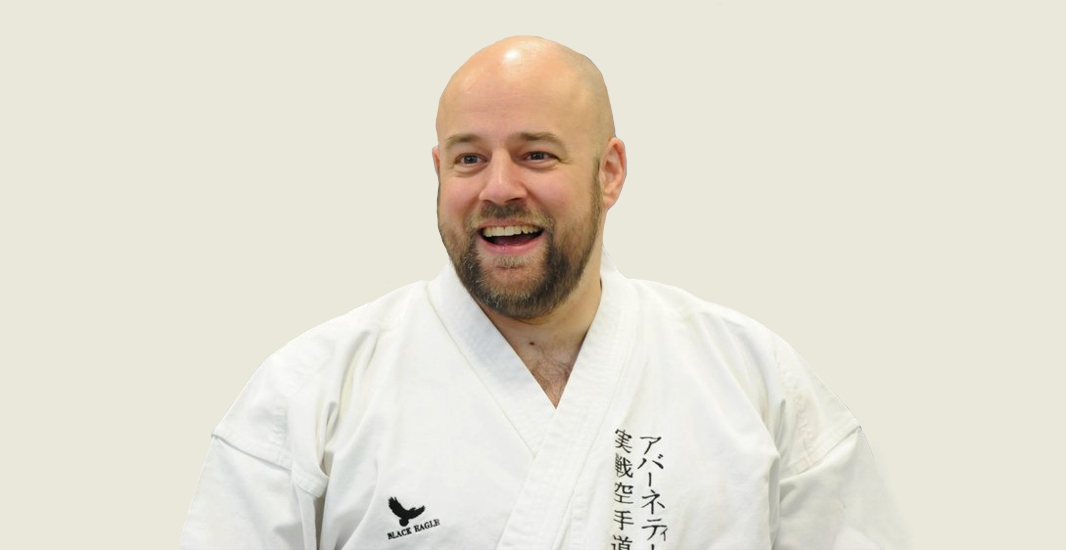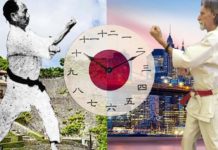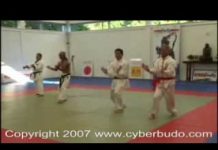There are many differing views on the value of kata. Kata is regarded by some to be the very ‘soul’ of the martial arts. By others, it’s regarded as a complete waste of time. To my mind, both views have merit depending upon what is meant by ‘kata’ and how it is approached.
One thing I think all martial artists can agree on is that the study of kata is definitely not a prerequisite for combative effectiveness. There are many highly-effective martial arts that do not include kata on their curriculum. A look at the effectiveness of the able practitioners of many ‘kata-less’ systems also shows that you can definitely produce effective martial artists without resorting to kata. If kata training is not a must in order to develop fighting skill, why do ‘traditional systems’ like karate bother with kata?
To fully explore the above question we need to understand why kata were created in the first place. Someone somewhere must have believed that kata served a useful purpose otherwise kata would never have come into being. By way of example, let’s discuss the creation of the karate kata ‘Chinto’ (renamed ‘Gankaku’ in Shotokan).
Chinto kata is named after a Chinese martial artist and sailor of the same name. During the 1800s, Chinto became shipwrecked on Okinawa and set up ‘home’ in a cave. Finding himself stranded, Chinto began to steal food and livestock from the locals at night in order to feed himself. This unwelcome behaviour was reported to the Okinawan king who sent Sokon Matsumura – a legendary karate master who was employed by the king as his chief bodyguard – to deal with the situation.
Matsumura was a very skilled fighter who normally defeated his opponents with ease. However, when confronted by Matsumura, Chinto fought back and Matsumura found himself equally matched. Always keen to further enhance his formidable skills, Matsumura made a deal with Chinto; he would take care of him in exchange for instruction in Chinto’s fighting method. Upon Chinto’s return to China , Matsumura formulated a kata – named after the originator of the methods it contained – to ensure Chinto’s methods were recorded and passed on to future generations. Many other kata were also developed by an individual’s students in order to record what they had been taught (i.e. Kushanku kata and Wanshu kata are also both named after Chinese martial artists who visited Okinawa ).
What has eventually become known as ‘karate’ is in fact a mix of many different fighting systems (cross-training is nothing new). The past masters used kata as a means to record the lessons they had learnt from various individuals and fighting systems and to then pass those lessons on to others.
We can also learn more about the nature of kata by examining the teachings and writings of Choki Motobu (one of Okinawa ‘s most feared fighters). Motobu helped spread karate throughout mainland Japan through his widely reported victory over a Russian boxing champion in a Judoka vs. Boxers tournament (it is said that Motobu entered the tournament because he was in need of the prize money in order to pay his rent).
Karate was not widely known at the time and Motobu entered the tournament as a Judoka because he found the rules imposed upon the Judoka to be the least restrictive i.e. the Judoka were not allowed to strike with a clenched fist, which was fine as Motobu was happy to use open-hand strikes etc. News of the bout spread rapidly throughout Japan and people wanted to know more about the system that had allowed the aging Motobu to easily defeat his opponent. As a result of this interest and publicity, Motobu became a professional teacher.
When people went to train with Motobu, they went to him to learn how to fight. Motobu regarded the study of kata (specifically Naihanchi) to be a vital part of that process. When discussing kata, Motobu once wrote, ‘The Naihanchi, Passai, Chinto and Rohai styles are not left in China today and only remain in Okinawa as active martial arts.’ (‘Okinawan Kempo’ translated by Ken Tallack). I’ve always found it interesting that Motobu refers to the kata listed as ‘styles’ and ‘martial arts’. It would seem that Motobu also considered each kata to be a record of a fighting system.
From the examples of Chinto, Matsumura and Motobu, we can see that kata were developed to ensure that the most effective methods of a particular individual or style were not lost. Kata can therefore be defined as ‘a way to record and summarise the key combative techniques and principles of a fighting style’.
Matsumura and Motobu were very able fighters. Matsumura was the chief bodyguard to the Okinawan king; a high-profile, high-status job that would only be given to the most able of fighters. Motobu was also known to have ‘tested’ his fighting skills hundreds of times without defeat during street brawls. Both Matsumura and Motobu were pragmatic fighting men and would have had little interest in kata unless they believed it served a practical purpose.
As a way to record techniques, drills and principles, kata certainly works. Hundreds of years after Chinto finished teaching Matsumura his fighting method, we modern karateka have a record of the key points of Chinto’s teaching. However, over time kata has drifted away from being viewed as a record of highly-potent fighting methods, to instead being generally considered as an athletic or aesthetic pursuit that has little relation to actual combat. Regardless of how kata may be perceived today, for karateka with an interest in the original civilian fighting system, kata provides a living link back to that system (see my Bunkai-Jutsu book).
To practise karate as a pragmatic system, kata needs to be actively studied, as opposed to just ‘practised’. Gichin Funakoshi (founder of Shotokan Karate) considered the practise of kata without learning to apply them in live situations to be ‘ useless’ (Karate-do Kyohan). Numerous other masters were also very critical of karateka who only emphasise the aesthetic performance of the kata. To my mind, without in-depth study of bunkai (kata application), kata practise loses all meaning. We should always keep in mind that kata were created to record fighting techniques and principles.
Kata is a record of the fighting systems that combined to form karate; the original ‘syllabus’ if you will. In Geoff Thompson’s book ‘The Pavement Arena’ he states, ‘ It’s not that the content of the karate syllabus is lacking, more that the syllabus is not fully utilised. A closer look at kata will divulge not only the manoeuvres we have all come to know and love, but also grappling movements, throws, hook and uppercut punches, eye gouges, grabs, knee attacks, ankle stamps, joint strikes, head-butting and even ground fighting. Have a look at your own dojo. How much of this information has been discovered, utilised and taught therein? When I had my own karate club all these techniques and more were covered. Why? Because they encompass every eventuality in all scenarios; a necessity if one is to be at all prepared for an attack.’
I think that is a great paragraph that succinctly sums up the key issues relating to kata and modern karate. Many karateka ignore the lessons of kata and therefore inadvertently practise karate as a ‘partial’ art. Without an understanding of kata, karate is a grossly inadequate and incomplete system. As Geoff says, we need to fully utilise ‘the syllabus’ if karate is to be effective. And, as we’ve already discussed, for karate – and arts like it – kata is the syllabus!
Can you imagine what a state karate would be in without kata!?! We would have no syllabus to work to! Everything that the masters of the past had discovered, perfected, learnt, taught and used would be lost. All we would be left with would be the modern techniques of karate’s competitive offspring. Don’t get me wrong, I have great respect of the athleticism of modern karate’s competitive wing. However, it has to be said that for everyday karateka the techniques of competition are woefully inadequate for use outside the tight confines of the sporting environment.
The drift away from the combative methods recorded in the katas towards competitive sport began as soon as karate made its way to mainland Japan. Whilst some were interested in the fighting art of karate (i.e. the students of Motobu), the Japanese were generally keen to create ‘martial sports’ out of the martial arts (Kenjutsu gave way to Kendo, Jujutsu gave way to Judo, etc.). If karate was to thrive in Japan , it would also need to adapt to the prevailing ethos.
To be embraced by the Japanese martial arts community at the time, karate would need a standard training uniform, a ranking system and a method of competition (the basis for all of which were ‘borrowed’ directly from Judo). However, despite these moves towards sport and physical recreation, kata was still strongly emphasised by the masters of the time. I feel this was undoubtedly so that the original combative syllabus wouldn’t be lost to antiquity. Kata has certainly been successful in that regard, as is evidenced by the ever greater number of karateka that are abandoning ‘modern karate’ to return to the functional and pragmatic system recorded in the katas.
Kata forms the holistic syllabus of karate, and therefore we need to ‘bother’ with kata in order to embrace that syllabus. There is definitely merit in kata as a method of recording and preserving combative techniques and concepts. However, is there merit in kata as a training method?
There are essentially two types of kata; solo kata and kata you perform with a partner. In modern martial arts, most people associate the term ‘kata’ with solo kata. Two-man kata are most often classed as ‘drills’. It’s almost universally accepted that drilling techniques with a partner (two-man-kata) is a valid training method. It tends to be the value of solo kata that is questioned more vigorously. It would seem to make much more sense to practise techniques with a partner than performing them on your own. So why practise solo kata? Surely, two-man-kata is a better way to practise techniques and concepts?
Drilling techniques with a partner (including sparring) is undoubtedly a more effective training method than solo kata. However, it is faulty logic to extrapolate that very obvious truth to then state that solo kata has no value. Getting into a boxing ring and sparring is more realistic than training on a punch bag (bags don’t hit back). If you apply the same ‘logic’ as many do to kata, you’d conclude that because sparring is more realistic than hitting a bag, bag-work has no value and therefore boxers should never use a punch bag! Surely we can use a punch bag and spar. We will develop our punching power on the bag, and then learn to apply those punches in sparring. Like many aspects of martial training, bag-work is most useful when approached as part of the whole.
In common with bag work, solo kata also needs to be part of the whole in order to derive real combative benefit from it. We need to regularly practise techniques with a partner in both compliant and non-compliant ways; but that does not mean that we should abandon the solo practise of the kata. Solo-practise and practising with a partner both have a role to play.
Kata is often criticised for being an ineffective ‘alternative’ to two-man training. Indeed, solo kata is an ineffective alternative to two-man training! However, those who make that criticism misunderstand the role of kata. On the other hand, there are others who value kata, but again misunderstand its purpose and role, and hence consider it to be a valid ‘alternative’ to two-man training (it isn’t!). Both positions are flawed because kata is not an ‘alternative’ to two-man training or anything else!
A pragmatic karateka will practise the solo-kata (the very syllabus of karate); they will drill the techniques with a partner; they will practise varying the techniques in accordance with the underlying principles to make them work for them as individuals; they will spar using those techniques; they will hit the pads; they will workout on a bag; they will lift weights; they will physically condition themselves; they will drill strikes, throws, locks, chokes, strangles and the whole range of techniques recorded in the katas. In short, they will train in all the ways needed to ensure combative effectiveness. Solo-kata should be part of a unified whole, not something you do to the exclusion of anything else.
On the days where you don’t go to the class and you don’t have a training partner, don’t take a day off! You can practise solo kata, and thereby physically condition yourself as you rehearse the whole syllabus of combative techniques, concepts and movements recorded by the founders of the art. And in addition to your kata, do some bag work, some ‘shadow boxing’, some conditioning exercises, and any other amount of the solo-training methods that can enhance martial skill.
On your training days where a partner is available, rather than practise the solo kata, you’d undoubtedly be better off practising the bunkai (applications) of the kata. Do the techniques, the corresponding two-man drills, and then utilise the whole range of kata techniques in your sparring (with some obvious exceptions in the name of health and safety). If you’re an instructor, you need to teach all aspects of kata. Students need to learn the solo-kata, the corresponding two-man techniques, drills and sparring methods. Your students will then be practising kata in a meaningful way and will be better able to pass on the skills the katas record when they themselves become instructors.
Kata is not an ‘alternative’ or ‘substitute’ for two-man training; it is the syllabus that tells us what to do in that two-man training and a means of supplementary solo practise.
Differing arts have differing ways of recording and passing on skills and information to subsequent generations. Kata, hyungs, forms etc are just one method to record and pass on information; however, kata have proved to be a fairly effective method for hundreds of years. For arts that have chosen other ways to ensure a continuity of information, there is certainly no need to bother with kata. However, for those arts that have historically made use of kata, practitioners need to ensure that they fully embrace those kata.
When modern day practitioners of karate choose not to bother with kata, they often do so in the name of ‘realism’. What they fail to realise is that by abandoning kata they have effectively abandoned the very syllabus of the original fighting system. Without kata, all that remains of karate is a ‘shell’ of the original art and modern day sporting techniques.
Kata has great value when correctly approached. It is the very thing that ensures karate is a workable system. If we approach kata in the way we were originally supposed to, we will ensure that karate is a functional, holistic, and pragmatic martial system.






